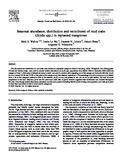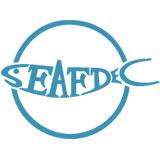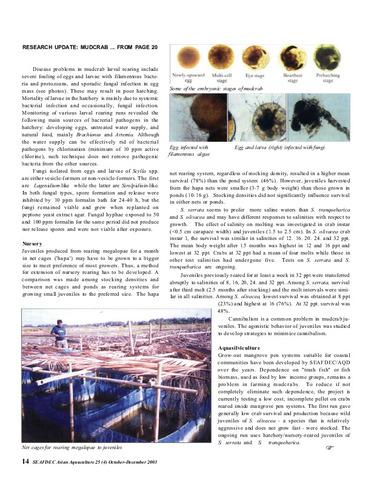| dc.contributor.author | Lebata-Ramos, Ma. Junemie Hazel | |
| dc.contributor.author | Solis, Ellen Flor D. | |
| dc.contributor.author | Sibonga, Rema | |
| dc.date.accessioned | 2023-09-05T01:47:34Z | |
| dc.date.available | 2023-09-05T01:47:34Z | |
| dc.date.issued | 2024-01 | |
| dc.identifier.citation | Lebata-Ramos, Ma. J. H., Solis, E. F. D., & Sibonga, R. C. (2024). The reestablishment of mangrove crabs (Scylla spp.) in an abandoned pond following natural mangrove recolonization. Restoration Ecology, 32(1), e14003. https://doi.org/10.1111/rec.14003 | en |
| dc.identifier.issn | 1061-2971 | |
| dc.identifier.uri | http://hdl.handle.net/10862/6479 | |
| dc.description.abstract | Scylla spp. are among the most economically important fisheries resources derived from the mangroves. However, the widespread mangrove destruction resulted in the loss of habitat, thus the dwindling capture production of many mangrove-associated faunas. Although studies have shown that Scylla populations have reestablished in mangrove-reforested areas, this study was the first in a mangrove-recolonized abandoned pond in the Philippines. Six fishers conducted standardized fishing every spring tide of the month using cylindrical bamboo traps. All crabs caught from July 2010 to December 2011 were recorded for species, sex, sexual maturation of females, carapace width (CW), and body weight (BW). Total landings comprised 14,262 crabs weighing 1,743 kg; 79.67% Scylla olivacea, 20.18% S. tranquebarica, and 0.15% S. serrata. CW ranged 3.1–17.1 cm and BW 10–1,250 g, with the male crabs comprising 39.23–64.65% of the monthly landings and the females distributed as 19.88–45.01% immature, 0.50–16.57% mature, 0.45–16.02% gravid, and less than 0.10% spent crabs. Monthly landings ranged 254–1,231 pcs of crabs or 32.38–160.59 kg. The monthly mean catch per unit effort (CPUE), in terms of number, was 0.101 ± 0.01–0.456 ± 0.02 crab gear−1 day−1 (max = 1.13), while in terms of biomass, 12.86 ± 0.84–54.36 ± 3.16 g gear−1 day−1 (max = 112.50). Length–weight relationships of S. olivacea and S. tranquebarica are expressed as W = 0.224967L2.9864 (r2 = 94.08%, p < 0.001; n = 11,363) and W = 0.173409L3.1074 (r2 = 92.71%, p < 0.001; n = 2,878), respectively. This study revealed that Scylla spp. could reestablish in mangrove-recolonized abandoned ponds. | en |
| dc.description.sponsorship | The Project Team greatly appreciates the Government of Japan Trust Fund (GOJ-TF) and the Aquaculture Department of the Southeast Asian Fisheries Development Center (SEAFDEC/AQD) for jointly funding the project (Study Code FS-03-C2010T) | en |
| dc.language.iso | en | en |
| dc.publisher | Wiley | en |
| dc.subject | Scylla | en |
| dc.subject | Scylla olivacea | en |
| dc.subject | Scylla tranquebarica | en |
| dc.subject | Scylla serrata | en |
| dc.title | The reestablishment of mangrove crabs (Scylla spp.) in an abandoned pond following natural mangrove recolonization | en |
| dc.type | Article | en |
| dc.citation.volume | 32 | en |
| dc.citation.issue | 1 | en |
| dc.citation.spage | e14003 | en |
| dc.citation.journalTitle | Restoration Ecology | en |
| dc.subject.asfa | crab culture | en |
| dc.subject.asfa | mangroves | en |
| dc.subject.asfa | length-weight relationships | en |
| dc.subject.asfa | sex | en |
| dc.subject.asfa | size | en |
| dc.subject.asfa | species | en |
| dc.identifier.essn | 1526-100X | |
| dc.identifier.doi | 10.1111/rec.14003 | |
| dc.subject.scientificName | Scylla | en |
| dc.subject.scientificName | Scylla olivacea | en |
| dc.subject.scientificName | Scylla tranquebarica | en |
| dc.subject.scientificName | Scylla serrata | en |
| local.subject | body weight | en |
| local.subject | carapace width | en |
| local.subject | CPUE | en |
| local.subject | Scylla spp. | en |
| local.subject | SEAFDEC/AQD | en |
| local.subject | species and sex composition | en |



